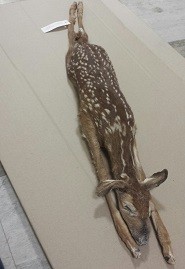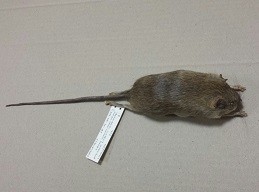- Biology Department
- Pre-Health Advisory Committee
- GIS Center
- Medical Laboratory Science
- Museum of the Earth Sciences
- Mathematics and Statistics
- REALISE
- Chemistry Department
- Radford University Planetarium
- Department of Physics
- Anthropological Sciences
- Geology
- Selu Observatory
- Center for Information Security
- Forensic Science Institute
- Biomedical Science
- Geospatial Science
- School of Computing and Information Sciences
- MS in Data And Information Management
History of mammal taxidermy

by Kayla McNeilly, 2015
Radford University hosts a wide selection of taxidermied specimens in the Biology Department’s Natural History Collection. There are over 15,000 specimens that include vertebrates, invertebrates, and plants that have been collected around the New River Valley and beyond (nationally and internationally). The mammal collection includes 87 species of over 700 cataloged and digitized specimens - from invasive Black rats (Rattus rattus) to native White-tailed deer (Odocoileus virginianus), and (fairly) new arrivals to Virginia, Coyotes (Canis latrans).
Taxidermy has been practiced for thousands of years and is known as a scientific study and art. This process is a skill that can be valuable to scientists and artists alike. However, the preservation of such specimesn has changed greatly in the last century. For many older taxidermy collections, the animals are laced with arsenic, once a main ingredient for taxidermy. Arsenic is a chemical element that can be found in soils, used in taxidermy since the 5th century BC. It was placed in the underside of the skin of an animal to help preserve and protect it from insects. It’s now recognized as a toxic chemical when exposed to humid air, and is a common ingredient used in rat poisons. This chemical is hazardous to humans (Marte et al., 2006).
Around the 18th century, taxidermists started mixing the arsenic with other materials like aloe, alum, and even cinnamon to help make the specimens smell better. Many of the specimens had the odor of sulfur on them, which also made the specimens change colors and even caused them to burn. Bécoeur is a well-known figure in the art of taxidermy, known for his arsenical soap that museums employed world-wide. Arsenic in museums collections has been prohibited since the 1980s because of the toxins. With this ban many museums had to inspect all of their displays for signs of arsenic. If it was found the specimens were documented and labeled with tags, warning users to wear gloves if handling these particular animals (Marte et al., 2006).

Because the use of arsenic is banned, Borax has emerged as a safe alternative, also known as a product to supplement laundry detergents. It is also applied to the on the skin of a specimen. This chemical compound is said to help dry skins and for fluffing animals. It is safe and not hazardous towards human skin (Grantz, 1969). Due to the possession of older specimens in the collection, pre-1980, classroom use is controlled and cases remain locked for safety of the valuable, irreplacable specimens (each represents a piece of history) and of students. If any specimens are used in classes, students are required to wear gloves.
Radford University’s biology collection is not just for science majors but also for Radford students to enjoy in the halls of Reed and Curie Hall, during lab times or by searching the database through a link through this museum web page. It is also available for students that request specimen data for research and teaching purposes. The collection is often used as a learning tool for visitors and even the students on campus (Dr. Karen Powers, personal communication).
Grantz, G. J. (1969). Home book of taxidermy and tanning. Mechanicsburg, Pennsylvania: Stackpole Books.
Marte, F., A. Péquignot, D. W. V. Endt. 2006. Arsenic in taxidermy collections: history, detection, and management. Collection Forum, 21(1-2), 143-150